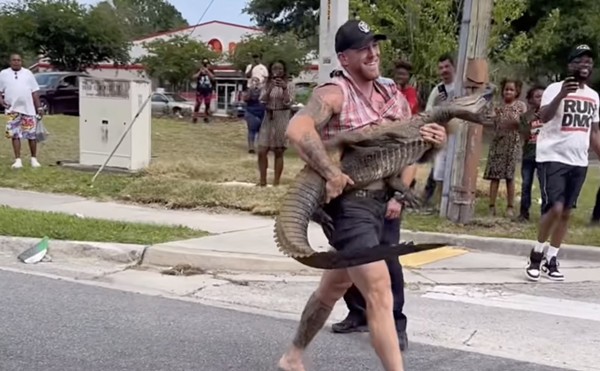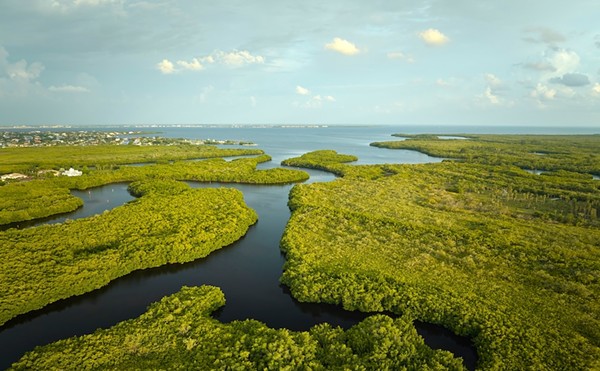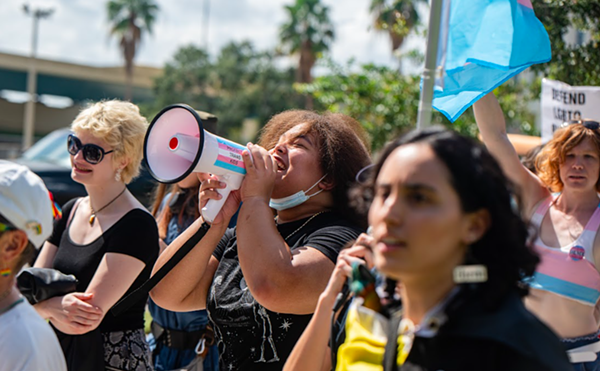A few years ago, out in the farthest reaches of the Panhandle, in tiny Okaloosa County, population 190,083, Mark Bellinger hatched a plan. It wasn’t a good or smart plan, and it was very much an illegal plan, but it was a plan nonetheless. It was August 2010, a few months after the BP oil spill, and Bellinger was the new head of the county’s Tourism Development Council, a position of some importance given the area’s reliance on the tourists drawn to the pristine white sand beaches of Fort Walton Beach and Destin.
Bellinger, in charge of drumming up tourism, decided a promotional campaign was in order. And so he asked the county’s ad agency to purchase for him the campaign’s ostensible centerpiece, a $48,000 Porsche. The agency complied, and billed the county under the line item “Prize for 2010-2011 Internet/Viral Video Contest.”
In early 2012 he had the same agency purchase a 40-foot, $710,000 Marquis yacht, purportedly for another marketing effort. He also allegedly embezzled $747,000 from the county’s BP settlement to buy a house.
The yacht was his unraveling. A few days after the county finally noticed this large, unapproved expenditure, Bellinger resigned. A few days after that, with the sheriff’s office coming to arrest him, he committed suicide by overdose.
The scandal made headlines, but its aftermath had ramifications for every tourist trap in the state, Orlando included, and elucidated an equation we’ve been grappling with for decades: balancing a powerful industry’s avarice with a struggling community’s needs. In this equation, at least in Florida, the industry almost always wins and the community almost always loses.
This was certainly the case in Okaloosa County. The ensuing state audit found that, over a two-year period, county officials had shuffled $2.5 million from hotel taxes to pay for lifeguards and beach patrols. Tourists, the thinking went, appreciate safe beaches, and paying for them out of the county’s general fund meant fewer cops and firefighters for everyone else, so why not?
It was hardly a salacious revelation, but it was still illegal. Under state law, tourism taxes are set aside for tourism promotion, and lifeguards and beach patrols, though they make things better for tourists, don’t count. So earlier this year, Okaloosa County officials beseeched the Legislature to let them use tourism taxes for beach safety, arguing that they shouldn’t have to break the law to do something that accords so perfectly with common sense.
The state’s tourism industry – a potent, influential group that spends millions of dollars a year to keep local and state politicians in line – balked. “Now the Pandora’s box opens to every conceivable use,” Gregg Nicklaus, president of the Sirata Beach Resort and Conference Center in St. Pete Beach, told the Tampa Bay Times. If the state lets counties spend tourist taxes on lifeguards, what’s next? Schools? Public transportation? Police? “Our industry has, for the most part, been united in opposing the expansion of the use of these tax dollars that were meant for marketing and marketing only.”
In other words: It’s our money. Keep your damn hands off it.
The obsequious state House of Representatives rejected the county’s request.
To hear the tourism industry tell it, this “marketing only” dictate was handed down from the mountain on stone tablets. It is fixed and immutable, as constant as the Pythagorean theorem, as unalterable as scripture.
“I hate when it’s called the ‘hotel tax’ or the ‘bed tax,’” says Richard Maladecki, the president and CEO of the Central Florida Hotel and Lodging Association. The tax was designed 36 years ago “to promote tourism. That’s why it’s called the tourist development tax, to have a tax specifically earmarked for tourism promotions.”
Already in Florida, local governments have tapped the tourism kitty to build sports stadiums – as well as museums and performing arts centers – often over the industry’s objections. State law is amenable to these projects under the theory that professional sports teams boost local economies by luring gobs of outsiders. That’s how the Amway Center was built. But that’s as far as this Pandora’s box opens.
In 2007, during the debate on the downtown venues – the Amway Center, Dr. P. Phillips Performing Arts Center and renovated Citrus Bowl – we were told time and time again that this was our only option if we wanted to derive some benefit from the industry’s pot of gold. It was Them versus Us, Tourism versus Venues.
But what if those weren’t our only choices? Or to put it another way, what would this conversation look like if the question weren’t Tourism versus Venues, but instead Tourism versus Venues versus Schools and Infrastructure and Police?
That’s a question worth keeping in mind over the next few weeks as Orange County considers spending another $57 million in tourism taxes on downtown venues, including a proposed new soccer stadium.
It’s been six years and one month since the Orange County Commission signed off on Orlando Mayor Buddy Dyer’s $1 billion-plus venues proposal. Those were controversial projects made more palatable by their funding scheme. About half the money, $540 million, came from Orange County’s tourism tax – the 6 percent surcharge the county levies on hotel rooms, which generated nearly $178 million in 2012 – so, in Dyer’s view, local taxpayers weren’t on the hook, just tourists.
Some (but not all) hoteliers protested. At one point, Harris Rosen, the industry titan and philanthropist whose name adorns five area hotels and the College of Hospitality Management at the University of Central Florida, argued that these venues would benefit “the wealthy few.” After the county approved the venues deal, he mounted a short-lived campaign to force a referendum on the subject. But in the end, the Amway Center opened in 2010, right on schedule, and is today hosting Orlando Magic games and Taylor Swift concerts.
The performing arts center and Citrus Bowl, however, have found themselves bedeviled by delays and funding shortfalls. And so on Tuesday, Aug. 6, they were in the Orange County Commission chambers pleading for more money: $12 million for the Citrus Bowl renovation, without which Florida Citrus Sports officials claim they won’t be nationally competitive; and $25 million to “expedite construction” of the arts center’s second phase and “jump-start” the necessary philanthropy, according to a county slideshow prepared before the hearing. (That presentation also noted that spending on the “most popular venue” – the arts center – “reduces the pressure to broaden the use of” tourist taxes.)
This package’s shiny hood ornament is the 20,000-seat downtown soccer stadium, built to house Orlando City Soccer, which needs the facility to become a Major League Soccer franchise (“Goal rush,” May 8). The stadium’s first phase would cost $85 million, of which $30 million would come from the team, $20 million from the city, $20 million from tourism taxes and $15 million from unidentified “other sources.” Orlando City also hopes to win $30 million in state sales tax rebates during next year’s legislative session, which it would use to complete the stadium.
Tourism honchos, skeptical of their funds being raided again, worked mostly behind the scenes. In separate letters to the county, Rosen and the CFHLA demanded that tourist tax money first be spent on improvements to the Orange County Convention Center – already the second-largest convention center in the country – and Visit Orlando, the tourism-marketing agency that receives more than $36 million a year in tourism funds. Only then, if tourism revenues continue rising at a hellfire clip, at least 5 percent a year, would they be willing to talk about those other things.
In an interview the day after that County Commission meeting, Maladecki was circumspect, careful not to say anything too pointed about the venues, which he says his organization is still evaluating: “The idea of utilizing the tourist tax for venues is a legal use of the law. The industry and elected leaders need to always examine the ROI and see what the best return is to maximize visitation.”
At the hearing, Orange County Mayor Teresa Jacobs offered an assessment sympathetic to the industry’s concerns: “Before transformation comes, we must ensure a strong foundation. With respect to the use of [tourist taxes], which are limited in their purpose, as a non-negotiable starting point, always we must protect our public economic engine, our Orange County Convention Center.”
Two days later, on Aug. 8, mayors Jacobs and Dyer announced an agreement fashioned to please everyone: The venues would get their money. In addition, Visit Orlando would receive an extra $25 million over the next five years for tourism promotion, as well as $2.5 million earmarked specifically for sports marketing; and the convention center, the tourism industry’s crown jewel, would receive an additional $10 million. The total price tag: $94.5 million.
Dyer’s office called it a “win-win-win for all the partners involved.”
In the beginning, back when Walt Disney was surreptitiously gobbling up swampland in Central Florida, there were no hotel taxes, at least not in most of the state. (Dade and Broward counties levied resort taxes.) But after Disney World opened its gates in 1971, drawing nearly 11 million visitors its first year and quickly becoming the anchor of a burgeoning attractions industry, the lodging community started lobbying Tallahassee with a proposal: They’d agree to a hotel tax if the state used that money to promote their interests.
The result was the 1977 Tourist Development Act, which gave counties the option to charge a 1 or 2 percent tax on hotels and other short-term accommodations. Per the industry’s demands, that money could only be used to advertise tourism and build and improve convention centers and sports facilities.
Orange County moved swiftly. In April 1978, county voters approved the 2 percent tax, which in its first year generated $3 million. By 1983 it was $6.6 million – then, as now, the largest collection in the state. The tax’s priorities were codified in the county code: the convention center, marketing and the original Orlando Arena. Decades later the downtown venues were added, with a pittance left over for cultural amenities like United Arts and the Orlando Science Center.
Over the years the state has allowed counties to expand their tourist tax: 1 percent for professional sports here, 1 percent for “high-tourism” counties there, and so on. The funding formulas became more complex. Some counties could charge more than others, and even today a couple opt not to have a tax at all. Orange County maxed out its tourism tax revenue in 2006, going to 6 percent as a prelude to the downtown venues deal. (The extra revenue was split between the venues and tourism promotions.) That year, the county collected $137 million in tourist taxes. In 2012, it was $177.6 million. In the 2013-2014 fiscal year, the state projects that Orange County’s haul will be $190 million, by itself nearly a third of the state’s expected $645 million take.
The local tourism industry, meanwhile, is recovering apace from the recent recession. “We’re the only destination in the history of the United States that has proudly featured 50 million visitors for three straight years,” Maladecki says.
Tourism generates more than $71 billion a year in statewide revenue and accounts for 23 percent of the state’s sales taxes, which is, as Maladecki points out, a big reason we don’t have an income tax.
In the industry’s view, the status quo is working just fine, and there’s no reason to mess with it.
"People have to look at, what is tourism about, and is it serving the local residents?” says Mark Soskin, an associate professor of economics at UCF. Soskin is an outspoken critic of public subsidies for sports facilities, including the Citrus Bowl and proposed soccer stadium, which he says – and the economics literature overwhelmingly agrees – does little or nothing to stimulate local economic growth.
Soskin’s also a critic of tourism in general – or more specifically, our region’s reliance on it. “There are no tourism industries that last,” he says. “There is a life cycle for destinations. They come and they go. We have to look beyond that point: Is it something that gets us there? It can’t be what we are.”
For all the revenue it generates, tourism isn’t without downsides. It requires a low-wage, low-education environment to thrive. “It’s in [the industry’s] interest to lobby as much as possible to keep wages as low as possible,” Soskin says. “They realize there are no high-wage tourism areas.” It’s no coincidence, then, that the Census ranks Orlando 45th out of 51 major metropolitan areas in median income.
Tourism, because it enables the state to eschew income taxes, also leads to a regressive tax system that penalizes the poor, who pay a larger share of their income in sales taxes than do the wealthy. Tourists clog roads and drain police resources. And tourism has high seasonal volatility, which means that, for instance, “Daytona Beach has four to five times the police force any other city its size has,” Soskin says, because it has to have cops ready when the crowds come.
As deferential as local and state politicians are to tourism interests, there’s a very real question of whether we’re getting enough out of this Faustian bargain.
Sentinel columnist Scott Maxwell first raised that issue in March 2001, back when he was on the county government beat. Las Vegas, he reported, used $65 million of its tourist taxes every year on schools and roads. New Orleans used hotel taxes for education, too, and Chicago and Seattle spent it on infrastructure and other public works. Florida’s ironclad commitment to spending tourism taxes on tourism was an anomaly.
His reporting sparked what seemed to be building momentum for reform. Freshman state Rep. Andy Gardiner (R-Orlando) introduced a bill to broaden the tax’s uses. A Sentinel poll in April found that 70 percent of Central Floridians wanted the law changed. Even attendees at the Orlando Regional Chamber of Commerce’s annual HobNob that year – a pro-business crowd if ever there was one – voted 3 to 1 to spend tourism taxes on schools and transportation.
And then nothing happened.
Gardiner, now next in line to be Senate president, ran headfirst into the tourism industry’s clout. His bill didn’t even get a vote. The issue has come up a few more times over the years – in 2008, Key West asked the Legislature for permission to use this money for affordable housing; in 2009, the Miami-Dade County Commission wanted extra cops in its tourism district; Okaloosa County’s request earlier this year – but each time, the industry flexed its muscles and shut it down.
“This issue epitomizes the disconnect between public will and public policy as well as any I can think of,” Maxwell says. “We’re talking overwhelming public support, yet absolute inaction by our elected leaders, as a result of special interests.”
Those special interests’ sway is substantial. Every election cycle, industry associations and bigwigs pour millions of dollars into legislative and local races – not just to protect tourist taxes but also to fight gambling, boost marketing spending, prohibit mandatory sick leave and other causes. Disney alone donated more than $2.5 million in the state in 2012, almost all of it to Republicans. The Mouse has 16 registered lobbyists in Tallahassee. Universal Orlando has 13 of its own. The Florida Restaurant and Lodging Association has another 15.
Closer to home, Disney and Universal lobbyists are among the top fundraisers for and donors to Mayor Jacobs’ re-election bid, and the Central Florida Hotel and Lodging Association presented her State of the County address in June.
Tourism officials claim they need every possible dollar to remain viable. Business is fine today, they say, but another recession or terrorist attack could put it in a tailspin. Already at least one trend line isn’t favorable: The convention business – “our foundation … our public economic engine,” as Jacobs recently called it – is dying.
For years, analysts have noted the convention industry’s seemingly intractable decline. As the Brookings Institution reported in 2005, “Many cities have seen their convention attendance fall by 40 percent, 50 percent, and more since the peak years of the late 1990s. The sharp drop has occurred across a range of communities, including a number of the historically most successful convention locales in the nation.” Between 2000 and 2010, the number of convention attendees nationally declined by 40 million, even though there’s 20 million more square feet of convention space. “Governments refuse to stop making convention centers bigger and hotels even more dazzling,” Steven Malanga wrote in the Wall Street Journal in 2011, “arguing that whatever business remains will flow to the places with the fanciest amenities.”
The Orange County Convention Center is one of those places. Since opening in 1983, the OCCC has been in an almost constant state of expansion and renovation: phase two in 1989, phase three in 1996, phase four later in 1996, phase five in 2003, each costing hundreds of millions of dollars (adjusted for inflation). Last year, Orange County approved another five-year, $187 million capital improvement plan, and last week announced that it would fork over an additional $10 million.
Yet attendance is more or less flat. The 1.3 million people who visited the OCCC in 2012 is more than the 1.2 million in 2011, but less than in 2003 through 2006. Over the past decade, attendance numbers have hovered consistently between about 1.1 million and 1.45 million.
This is the wagon we’re hitched to, and where much of our tourism taxes go. In fact, most of the tourist tax revenues are already spoken for, at least for the next few decades: not just debt service for the convention center but also for the arena, the performing arts center, the Citrus Bowl and now perhaps the soccer stadium, not to mention marketing.
So even if Tallahassee changed the law, even if Orange County could use tourism taxes for public services, there’s no money left to spend.
This problem has a simple solution: Raise the rate. Every percentage point of hotel taxes in Orange County generates about $30 million, give or take, in annual revenue. If the hotel tax were raised from 6 percent to, say, 10 percent, that would amount to $120 million a year that could be set aside for infrastructure, roads, cops, schools or whatever else we choose. This is real money: Lynx, our public transportation agency, has an annual budget of $116 million; the Orlando Police Department’s is about $117 million.
Maladecki, of the Central Florida Housing and Lodging Association, isn’t keen on this idea. Tourism would suffer, he says. “It would put us at a competitive disadvantage. Why would we want to do this as an industry?”
The hotel tax rate here, however, is lower than in other tourism destinations. New York City, for instance, charges about 15 percent in hotel and sales taxes. Washington, D.C., 14.5 percent. Hawaii, 13.5 percent. Las Vegas, probably our closest analogue, levies a 12 or 13 percent tax, depending on the district.
Orange County’s rate, once you factor in sales taxes, is 12.5 percent. An average night’s lodging in the metro Orlando area, according to Visit Orlando, is $96.88. Raising tourist tax by 4 percentage points would tack on $3.88 to the bill.
We should also look at the broader picture: Earlier this month USA Today published an analysis of travelers’ tax burdens throughout the country – not just hotel taxes, but also sales taxes, rental car taxes and other fees tourists often don’t notice. In Chicago, tourists pay an average of $40.31 a day; in New York City, $37.98; in Seattle, $34.43; in Nashville, $34.13. In Orlando, they’re charged $24.50, one of the lowest rates in the U.S. As a result, New York generates $300 million more in tax revenue from $57 billion in tourist spending than Florida does from $71.5 billion.
Slightly higher hotel taxes won’t scare tourists away, at least no more that Disney’s or Universal’s annual price hikes do. They’ll merely put us closer to the national average – and in the process, they just might make Central Florida a better place to call home.
Florida is 43rd in per-pupil education spending. Twenty-six percent of its roads are of poor or mediocre quality. Seventeen percent of its bridges are structurally deficient or functionally obsolete. It needs $33 billion in drinking and wastewater upgrades over the next two decades and another $9 billion in school infrastructure improvements, according to the American Society of Civil Engineers. It also leads the nation in foreclosures.
Orlando is commonly ranked among the country’s most dangerous cities, ahead of Baltimore and Detroit and Miami, with violent and property crime rates that double or triple the national average. Lynx is almost criminally underfunded. The region is encumbered by a low-wage service economy, which begets all sorts of problems associated with poverty. And notwithstanding recent improvements, we still face a housing crisis.
These are needs. The venues are wants, amenities that will make life here more enjoyable for some people. The wants get funded while the needs linger because, politicians tell us, the tourist-tax law gives them no choice. (“There are some real restrictions on what we can do,” Mayor Jacobs said in last week’s county commission meeting.)
“Local officials love having their own hands tied,” Maxwell says, “so they have an excuse to throw money at sports buildings without the accountability that would accompany the spending if the money could otherwise go to cops or schools.”
This issue is bigger than the venues, though. Rather, it goes to the very heart of what kind of community we want to be.
“Tourism is generally bad for an area,” Soskin says. “The reason an area tolerates tourism is because it generates funds for the rest of the economy.”
This is our deal with the devil. It’s time we get our money’s worth.


















